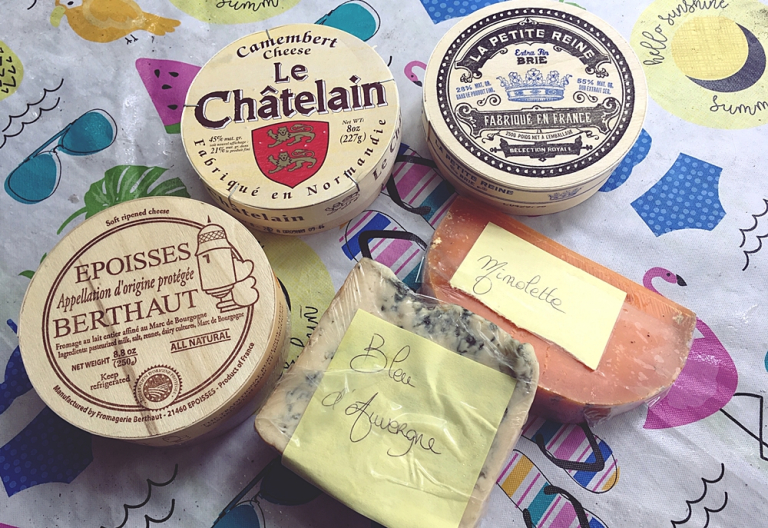I’m the only one in my family who hasn’t been to France. My parents, siblings, aunts, cousins, their kids . . . but really, when you enjoy cheeses from France, it’s a teeny bit like going there. It really makes a difference where your food comes from: it has to do with the micro-climate and microorganisms unique to places. I recall reading an article in now-defunct Lucky magazine . . . they found locations with very neutral micro-climates and tried to recreate exotic foods there. They were completely blah! That lets you know that authentic is the only way to go. Cheeses of Europe ”with a focus on the French dairy farmers and cheeses of France” makes it its mission to create awareness in the USA. Yay! I was happy to be hosted to experience them.

When learning about French cheeses, I’ve done quite a bit of studying of Steven Jenkins’ Cheese Primer, a book first published in 1996. He’s a well-respected cheese expert and monger. I was very pleased to read in the older book that certain lovely cheeses were among his favorites, but that ”at that time” they were not available in the US. Well, those days of deprivation are over!
Yes, it’s time to treat yourself to some accessible luxury. France has set the standard for luxury goods since the time of the Sun King, Louis XIV.
With many assertively flavored cheeses from France, they recommend a sweet Sauternes to pair. I had a nice tawny Port on hand and it worked very well. I also munched on a dry, slightly smoked salami with them.
Le Chatelain Camembert
When it comes to Camembert, you want it to come from Normandy, France. Again, that thing with the terroir. It makes all the difference. It’s a cow’s milk cheese with a straw colored rind that’s edible, soft and thin. It has a white bloom. Dating from the end of the 17th Century, it’s said that the recipe was rescued by a fleeing priest. Thus, the folklore that is why it “smells like feet”! I noticed a nose of grassy, rainy day barnyard notes.
It doesn’t taste like that, though . . . so that is one instance where your sense of smell will dispute with your sense of taste. It has an ivory paste (inside) that’s creamy, but not runny. I get flavors that are very mushroomy, with hard-boiled eggs and meat. It’s pleasantly salty.
It’s packed in a thin, wooden box, which is what you want in softer cheeses.
La Petite Reine Brie is a French maker of what is America’s favorite French cheese. People love the buttery, silky, cow’s milk cheese by itself, on sandwiches, topped with caramelized fruits and nuts, with a little brown sugar. That’s a great thing to haul out for a party, by the way. Experts suggest pairing it with fruity red wines or farm ales. It’s got a white, firm edible rind, with a salad-like nose.
Flavors are buttery, sea salt, meaty but mild. It doesn’t have the richer mushroom notes of Camembert. I also noticed flavors of sweet hay and popcorn. It’s very tasty and accessible.
It’s packed in a little wooden box.
Epoisses Berthaut The protected origin (Bourgogne [Burgundy]) version, was not available here at Jenkins’ writing. He rather felt sorry for those who couldn’t indulge in this cow’s milk cheese, but now we all can! Ask any gourmet, foodie, wine aficionado and Epoisses is usually #1 on their list. I’m a little embarrassed to admit that its aroma made me shake my head “no,” when it would roll along in a cheese cart. It’s got a barnyard aroma that can fill up the room!
It’s a washed rind cheese, with orange rind — washed with a local spirit called Marc de Bourgogne that gives the scent and seals in flavor. The paste is ivory and has a silky texture (you are leaving your cheeses out for an hour from the fridge, aren’t you?). Use a flat spoon or spreader for the paste. I eat the rind and enjoy it.
The neat part is: it doesn’t taste anything like it smells! I get salt, spice, smoke. Try it on grilled toast.
They suggest two opposite ends of the spectrum as a pairing: sweet white wines or dark, stouty beers.
Mimolette is a funny looking cheese! People love it on cheese plates. It looks like a bright, orange cantaloupe when cut open. Steven Jenkins says it tastes like a 2 year old Cheddar, comparable also to Gouda. I taste a lot more nuttiness, without the sour tang of Cheddar.
They suggest a pairing with a powerful red, like a Cabernet Sauvignon.
Bleu d’Auvergne is a special, unique blue. Terroir also makes the ultimate imprint here, as many other countries try to recreate it, but can’t. They can’t even come close. The cheese has a creamy, slightly crumbly paste with blue-green veins. I noticed salt, spice or pepper notes in the blue, chives and green grass. Mr. Jenkins noticed wild flowers, wild onions, grass and nuts.
They say it’s good on a burger. It might be! I love-love-love it on simple salads. It really elevates the stuff in bags.
Again, Sauternes or farm ale is suggested to pair, but I loved my tawny Port with it.
We are living in blessed times: look at all the places you can buy these interesting cheeses HERE.
To best present these culinary works of art, here are the preferred ways of cutting them, according to the esteemed Charles Duque, Managing Director, North America, The French Dairy Board:
The Proper Way to Cut Cheese
France is very proud of their cheeses. They take such great pride presenting them and are respectful when it comes to the perfect cut.
For Round Cheeses, Duque says start from the center and cut downward. Slice the cheese in triangles like you would a pie.
Camembert, Munster, Fourme d’Ambert
For Larger Size Round Cheeses, think Brie, cut the end piece off. Then cut another diagonal slice and a perpendicular one at the end of the rind, so each slice will have a bit of rind on it.
Brie
Pyramid shaped cheeses (or come shaped cheeses) are cut like round cheeses, in thin portions.
Valencay
Square Cheeses
Cut these cheeses like a cake, starting with a diagonal cut. You will have two triangles. Then cut each triangle in half and so on. Then you will have 4, 8 or 16 equal pieces.
Pont-L Eveque
Atypical Shapes
Cut it like round cheese. Intersect the middle in even-wedged, triangle slices.
Neufchatel
Slice of Small Wheels
The cheese should be laid flat. Slice a wedge from the center of thin edge to equally spaced points along the thick edge.
Mimolette, Roquefort
Slice of Large Wheels
Start on the core end, by cutting long slices parallel to the rind. Then at about mid-cheese, cut perpendicular to the rind.
Comte, Beaufort
#makeitmagnifique
Published by tamarmarcopolostyle — View all posts by tamarmarcopolostyle HERE





